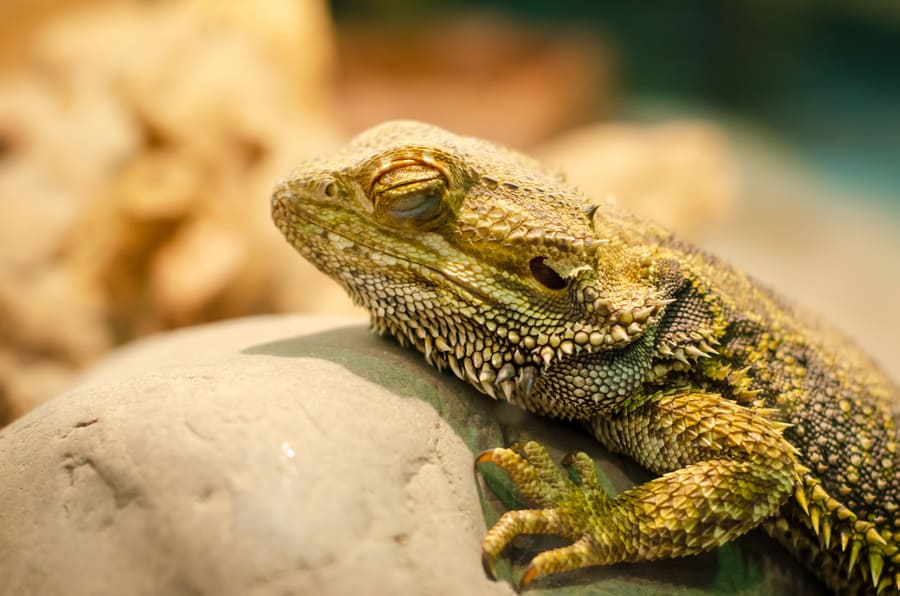
As you watch your bearded dragon, you may notice it doing peculiar things that leave questions in your mind. Is a bearded dragon sleeping in the corner normal behavior?
It is completely normal for a bearded dragon to sleep in the corner, especially if it is a baby or experiencing brumation. However, if this is a sudden change, or if it is accompanied by other symptoms, a bearded dragon sleeping in the corner may be a cause for concern.
In this article, we will dive deeper into the strange positions bearded dragons sleep and what could be the causes. Seeing your beardie resting in the corner of his enclosure may seem sad, but oftentimes, there is little to worry about.
Is Corner Sleeping Cause for Concern?
If the bearded dragon appears to be lethargic, then this should be a cause for concern. Lethargy is best described as the bearded dragon remaining in one spot for several days at a time and being unresponsive to stimuli. (Brumation, which is discussed in the next section, is an exception to this rule.) However, if the bearded dragon only remains in one spot for about a day, and if it appears to respond to changes in its environment, it should be just fine.
If your pet has other symptoms, such as swollen joints, lack of appetite, issues with shedding, or poor stools, this may indicate an underlying medical or environmental issue. The biggest possibilities are dehydration, lower temperatures, overly high temperatures, and stress. Other potential issues are malnutrition, impaction, and parasitical infections. These issues are discussed in detail in the next section.
Finally, if this is a sudden change, sleeping in the corner may point to the previously mentioned issues. Again, brumation may be the culprit, but it can also indicate lethargy and a sudden illness.
Reasons Why Bearded Dragons May Sleep in the Corner
The biggest (and fortunately harmless) reason why a bearded dragon may suddenly sleep in the corner, appear sluggish for several days, and stop eating is brumation. Not all bearded dragons experience brumation; however, it is a common issue. Much like hibernation, this habit lasts for several days to a few weeks and is a normal part of the bearded dragon’s seasonal cycle. Typically, this will occur during the fall and winter months as the temperatures drop. They seek the corner of the terrarium because it is cooler and feels safe.
Brumation is one of the few times when cooling the terrarium down by turning off the heat lamp is not only acceptable but also encouraged. In addition, you should not feed your bearded dragon during brumation, as the food can actually begin to rot since its digestive system is not fully functioning. However, please be sure to continue providing fresh water.
Because bearded dragons do not eat throughout their brumation, it is common for them to lose weight. If you are concerned about your bearded dragon’s weight loss, you can weigh it once a week, which will not disturb it much if you weigh it quickly. If the bearded dragon’s weight loss is significantly more than 4 grams, it may be experiencing parasites or a similar illness.
Another common issue, dehydration, can be problematic if prolonged, but it fortunately has a simple fix. A dehydrated bearded dragon will have overly stretchy and wrinkled skin, sunken eyes, a lack of appetite, and lethargy. This lethargy causes them to sleep more often and in odd spots, such as the corner of the terrarium. To help your pet recover, spray the terrarium and be sure you are regularly providing safe water.
Chlorinated water is an example of water that is not safe; the water you provide must be dechlorinated. Also, even if you are doing everything correctly, your bearded dragon may be picky with drinking water if you are providing it from a bowl. Fortunately, water dispensers are available online and in many pet stores.
When a bearded dragon’s terrarium has overly low or high temperatures, it may either become sluggish and therefore sleep in the corner or find a cool spot, such as the corner, to get away from the heat. To check for this issue, you may need to invest in a thermometer to check. Your bearded dragon’s terrarium should have a temperature of 80-90ºF in the cool area and 95-110ºF in the hot area. In addition, you may need to invest in better heat lamps (described in the next section).
In addition, stress can actually show itself through lethargy in a bearded dragon. Common culprits are issues within the enclosure, loud noises, or too much handling (they do not enjoy being handled, but they will tolerate it very occasionally for their owner). Because bearded dragons are naturally solitary creatures, sharing a terrarium with other bearded dragons also causes stress. Because of this, you should always house them alone, unless you want to bring two bearded dragons together briefly to breed them. Pets, like dogs and cats, walking around the cage also cause stress, so be sure to put your bearded dragon in a room where the pets cannot go if possible.
Bearded dragons experiencing impaction often have discomfort, which may lead them to sleeping in the corner of the cage. At the start of impaction, the main symptom is difficulty with bowel movements. The bearded dragon may also have a swollen belly, weight loss, and odd bumps on its back. If the issue is allowed to progress, your bearded dragon may have an awkward gait, shaky back legs, and potentially paralyzed front legs.
To prevent impaction or help resolve mild symptoms, ensure that the basking temperature is correct, and put your bearded dragon in a shallow, warm bath to encourage the impaction to move through. If your bearded dragon has impaction, you may also temporarily modify their diet by adding softer items such as pumpkin and warm (sugar-free) baby foods.
Your bearded dragon may be lethargic and sleeping in the corner as a result of malnutrition. Because the bearded dragon has a highly specific diet, you may be feeding it the wrong items. For example, it only needs a limited source of protein, mainly requiring fruits and vegetables. Crickets tend to have higher levels of fat, so you should only feed them to baby bearded dragons if possible (as noted by the CY-Fair Animal Hospital).
Among the vegetables, it should never eat items such as spinach, avocados, and rhubarb. Some greens that the bearded dragon can eat are red leaf lettuce and mustard greens. For more ideas on what to feed your bearded dragon, feel free to check out this website. Finally, your bearded dragon may be experiencing parasites. Although this is fortunately unlikely, if your bearded dragon has been struggling to gain weight or is suddenly losing weight, it may be experiencing this issue. Another common symptom of parasites includes diarrhea and poor stools.
Important: Your bearded dragon’s terrarium should have a temperature of 80-90ºF in the cool area and 95-110ºF in the hot area.

Heat Lamps & Sleep for Bearded Dragons
As previously mentioned, the wrong temperature may cause your bearded dragon to sleep in the corner. One of the biggest culprits is improper lighting, which may be too warm, too cool, or simply provided at the wrong time.
Although having a heat lamp to keep them warm is important, you also need to ensure that you do not have the lamp on at night. During this time, your bearded dragon is sleeping, and bright lighting may throw off its sleep cycle. If you are concerned about the temperatures dropping too low, a ceramic heat emitter and heat pad under the cage can provide sufficient heating (do not use red night lights, as they can still see the light). At the same time, however, temperatures do need to be a bit lower at night (70 to 75ºF), or your bearded dragon will become too hot, which will throw off its sleep cycle.
Cold temperatures can also disrupt sleep habits. If the room where you have the dragon’s enclosure in drops below 66 degrees F, use a ceramic heat emitter on top of the UVB light and basking lamp you already have.
If you do not have a lamp that provides UVA light, your bearded dragon may lack appetite and become lethargic. Over time, it may end up with more severe issues such as metabolic bone disease. Metabolic bone disease may cause weakness, swelling, and a further lack of appetite. To prevent this issue, ensure that your bearded dragon also has enough calcium and Vitamin D3 in its diet.
Finally, the terrarium needs an assigned cool area, or your bearded dragon will not have a place to cool down. As a result, it will seek out cooler places to sleep in, such as the corner. You can create a cool area by having the UVB lamp and basking lamp on the same side, so the heat only covers 2/3rds of the enclosure.
Does Age or Sex Affect Where Beardies Sleep?
Babies tend to sleep in odd positions more than even the adult bearded dragons (which are notorious for this habit) because they need more sleep to aid in their growth. In addition, older bearded dragons need extra sleep to conserve energy. Because of this, both age groups may gravitate to a safer, more comfortable spot such as the corner of the terrarium.
The sex of a bearded dragon does not significantly affect its sleeping habits. However, if a female bearded dragon has eggs, she may become more lethargic and sleep more, which causes her to seek out a place such as the corner of the enclosure. To keep warm, she will likely spend much of her time under the heat lamp.
Other Weird Sleeping Habits of Bearded Dragons
Bearded dragons need quite a bit of sleep—about 8 to 12 hours per night. In the summer as it gets warmer, they may sleep up to 14 hours per night. Because they sleep so soundly, their breathing may slow to the point that they appear dead at first glance, and the color of their skin may lighten. However, this is completely normal.
Also, bearded dragons tend to sleep in odd positions. For example, they may sleep vertically while leaning on an object. Although this is a strange and amusing habit, there is nothing to be concerned about.
Finally, bearded dragons tend to bury themselves under the sand of their terrarium. Although this is typically just a normal, healthy behavior, it may indicate that the bearded dragon is stressed and trying to hide. It may also be too cold.
Overall, bearded dragons have numerous quirky habits, including sleeping in the corner of their cage. If, however, you notice other symptoms and are concerned that your bearded dragon’s sleeping habits are a sign of a deeper issue, and if the steps suggested do not seem to help, this may be the time to contact a veterinarian who specializes in exotic pets. Your vet can help spot severe issues, such as impaction or a parasitical infection, and prescribe the needed treatment or medication to help your pet recover.
